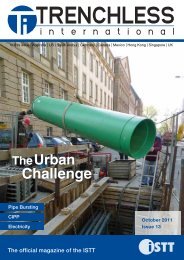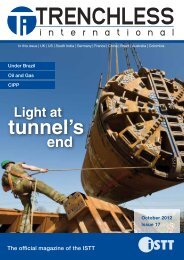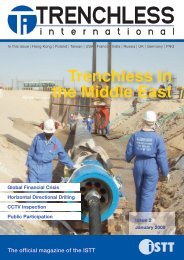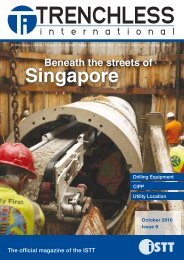North American Special - Trenchless International
North American Special - Trenchless International
North American Special - Trenchless International
Create successful ePaper yourself
Turn your PDF publications into a flip-book with our unique Google optimized e-Paper software.
Insertion of the liner takes about three hours.<br />
Cured liner in the accessible<br />
oval profile.<br />
shaft the liner was equipped with pressure<br />
locks so that it could then be expanded in<br />
the sewer using compressed air.<br />
projects<br />
April 2009 - <strong>Trenchless</strong> <strong>International</strong><br />
liners of 32.5 metres and 173.6 metres in<br />
length had to be installed, including all<br />
preparatory and related work.<br />
Light-curing GFRP liner<br />
The related work included the opening<br />
of the connection lines that are covered<br />
up by the liner. This work played a decisive<br />
role in the selection of the process<br />
— due to the time factor. The planners<br />
at HanseWasser decided at the outset<br />
that only light-curing GFRP liner systems<br />
were to be considered. With this pipe lining<br />
variant there is no need to consider<br />
the reduction of stresses in the liner,<br />
which can take several days. The lack of<br />
shrinkage means that there are no axial<br />
movements and the connections can be<br />
milled out directly after the curing of the<br />
liner without the risk of changes in length.<br />
Considering the high density of connections<br />
in Ostertorsteinweg and the fact<br />
that behind almost every connection there<br />
is a multi-storey residential building with<br />
retail space at ground floor level, smooth<br />
maintenance of the drainage was especially<br />
important. In order to maintain the<br />
drainage during the rehabilitation, DN 400<br />
free-flow pipelines were installed above<br />
ground for temporary water drainage,<br />
including sufficiently powerful pumps.<br />
At exactly 9:00 pm, the last train had<br />
just disappeared around the corner and<br />
the preparatory cleaning work began in<br />
the collection drain so that at 11:00 pm<br />
the Brandenburger construction crew<br />
could begin with the insertion of the liner<br />
through the start shaft near Poststraße. The<br />
10.4 tonne glass fibre tube was let down<br />
into the opened shaft out of the transport<br />
packaging and, using an electrical<br />
conveyor belt, pulled with a steel cable<br />
connection to the target shaft at the<br />
Weberstraße. A foil that had been laid<br />
down protected it from damage. At 2:00 am<br />
on Saturday morning, the entire 173 metre<br />
length of liner lay in the Ostertorsteinweg<br />
collection drain. At the start and end of the<br />
Lamp train and curing<br />
A lamp train with nine UV modules,<br />
each 1,000 watt maximum power, was<br />
pulled through the form-fit calibrated liner<br />
with pre-calculated speed. The connection<br />
to the new UV technology with the<br />
special resin recipe made it possible to<br />
also achieve curing in a very short time.<br />
The light-curing process lasted a total of<br />
four and a half hours at a train speed of<br />
65 cm per minute and was recorded in<br />
all relevant parameters, including speed,<br />
exposure dose and liner temperature. The<br />
computer-aided documentation of this<br />
data allowed for any eventual deviations<br />
from target values of the technical parameters<br />
to be recognised immediately and<br />
allowed tracking of the curing procedure.<br />
Connection lines<br />
Directly after the curing of the liner,<br />
work began to open the connections. By<br />
midday Saturday, all 48 residential connections<br />
in the rehabilitated collection<br />
drain were milled open and at the start<br />
of the tram traffic on Monday morning at<br />
9:00 am they were all connected according<br />
to the specifications of the client. This<br />
was accomplished with the installation of<br />
glass fibre short liners up to 50 cm over<br />
the first pipe connection. The direct support<br />
area was filled with an epoxy resin<br />
system so that it was waterproof and<br />
had no cavities. The local residents were<br />
hardly affected by the project in terms<br />
of disruptive effects normally associated<br />
with construction projects.<br />
Further construction sections<br />
The combined second and third construction<br />
sections in Ostertorsteinweg<br />
were performed over ten days. As the<br />
tram traffic was already suspended, there<br />
was not the same degree of time pressure<br />
as in the first section. Two 115 and<br />
128 metre long liners were installed with<br />
all preparatory and related work. There<br />
was a work pause of almost four weeks<br />
after the first construction section due<br />
to a large number of residential connections,<br />
in the area of the collection drain<br />
yet to be rehabilitated, that were renewed<br />
in open cut. This entailed excavation<br />
work but also the renewed preparation<br />
of the surrounding drainage conduit. The<br />
independent laboratory inspection, as<br />
a major component of the quality management<br />
system, was performed in the<br />
Ostertorsteinweg project by engineering<br />
company Siebert in Oststeinbek. Their<br />
analysis of the liner samples taken from<br />
the construction site came to the positive<br />
result that all specified parameter nominal<br />
values of all liners were exceeded by<br />
at least ten per cent.<br />
Summary<br />
HanseWasser was pleased with the<br />
successful and on schedule completion<br />
of the rehabilitation project. The successful<br />
Ostertorsteinweg rehabilitation project<br />
accentuated not only the special advantages<br />
of the liner process that was used,<br />
but is also another example for the plus<br />
factors of the trenchless pipe lining technology<br />
as a whole.<br />
The rehabilitation using pipe lining with light-curing<br />
reaction resin systems<br />
The procedure has already proved itself in 26 countries, in which<br />
over 2,000 km of sewers have been installed in diameters from DN<br />
150 to DN 1000. In principle, the Brandenburger pipe liner procedure<br />
is based on the same basic idea as all other liner. A tube support<br />
saturated with reactive synthetic resin is brought into the sewer,<br />
where it is expanded with inside pressure to be form-fitting, i.e.<br />
with no ring gap, and then cured by a chemical reaction of the resin<br />
to a self-supporting inner lining. This technology is consequently<br />
trenchless, as no type of earthworks are necessary. The flexible<br />
liner tubes are typically applied using existing inspection shafts<br />
in the sewer. The special characteristics that differentiate the<br />
Brandenburger liner system from other pipe lining types are:<br />
• Use of seamlessly wound liners out of glass fibre laminate webs,<br />
• Unique saturation of the raw materials before the production of<br />
the pipe liner with UV-reactive UP resin (possibly with addition<br />
of peroxides for the variation “hybrid curing” for larger wall<br />
thicknesses over 10 millimetres)<br />
• Drawing in the liner on a protective foil and form-fitting expansion<br />
using compressed air<br />
• Curing of the liner using precisely dosed UV exposure<br />
(“BLUETEC® technology”).<br />
projects<br />
April 2009 - <strong>Trenchless</strong> <strong>International</strong><br />
24<br />
25
















